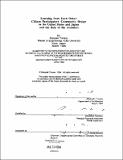| dc.contributor.advisor | Reinhard Goethert. | en_US |
| dc.contributor.author | Yonesu, Masaaki | en_US |
| dc.contributor.other | Massachusetts Institute of Technology. Dept. of Architecture. | en_US |
| dc.coverage.spatial | n-us--- a-ja--- | en_US |
| dc.date.accessioned | 2012-05-15T21:02:54Z | |
| dc.date.available | 2012-05-15T21:02:54Z | |
| dc.date.copyright | 1994 | en_US |
| dc.date.issued | 1994 | en_US |
| dc.identifier.uri | http://hdl.handle.net/1721.1/70679 | |
| dc.description | Thesis (M.S.)--Massachusetts Institute of Technology, Dept. of Architecture, 1994. | en_US |
| dc.description | Includes bibliographical references (p. 109-111). | en_US |
| dc.description.abstract | This thesis explored principles of community design for future development both in the US. and Japan by examining the organizational structures, levels of participation and processes of community designs. Three cases in the US. and two cases in Japan were chosen for case studies. The method of research included a critical review of the literature, personal interviews and neighborhood visits. At the same time, the roles of architects in design processes were discussed as well as the roles of other participants: community residents, city officials and other professionals who were involved in the projects. Levels of participation are defined by the distribution of power in decision-making, and each case is summarized in terms of levels of participation in each stage of chronological progression of the design process: use, pre-design, design, construction and habitation phase. The US. and Japanese cases were compared by means of seven criteria: contextual consistency, spatial configuration, consideration of the family variation, achievement, citizens' levels of participation, involvement of institutions and the relationship between the community and the government. Findings clarified that the social background of each nation, attitude of city officials toward urban redevelopment, technical skills of professionals and attainability of financial support affect the success and effectiveness of participatory community design. In conclusion six principles of participatory design were suggested to promote creative ways of including communities. Change in the role of architect were mentioned. | en_US |
| dc.description.statementofresponsibility | by Masaaki Yonesu. | en_US |
| dc.format.extent | 111 p. | en_US |
| dc.language.iso | eng | en_US |
| dc.publisher | Massachusetts Institute of Technology | en_US |
| dc.rights | M.I.T. theses are protected by
copyright. They may be viewed from this source for any purpose, but
reproduction or distribution in any format is prohibited without written
permission. See provided URL for inquiries about permission. | en_US |
| dc.rights.uri | http://dspace.mit.edu/handle/1721.1/7582 | en_US |
| dc.subject | Architecture. | en_US |
| dc.title | Learning from each other : citizen participatory community design in the United States and Japan, and the role of the architect | en_US |
| dc.title.alternative | Citizen participatory community design in the United States and Japan, and the role of the architect | en_US |
| dc.type | Thesis | en_US |
| dc.description.degree | M.S. | en_US |
| dc.contributor.department | Massachusetts Institute of Technology. Department of Architecture | |
| dc.identifier.oclc | 31258745 | en_US |
